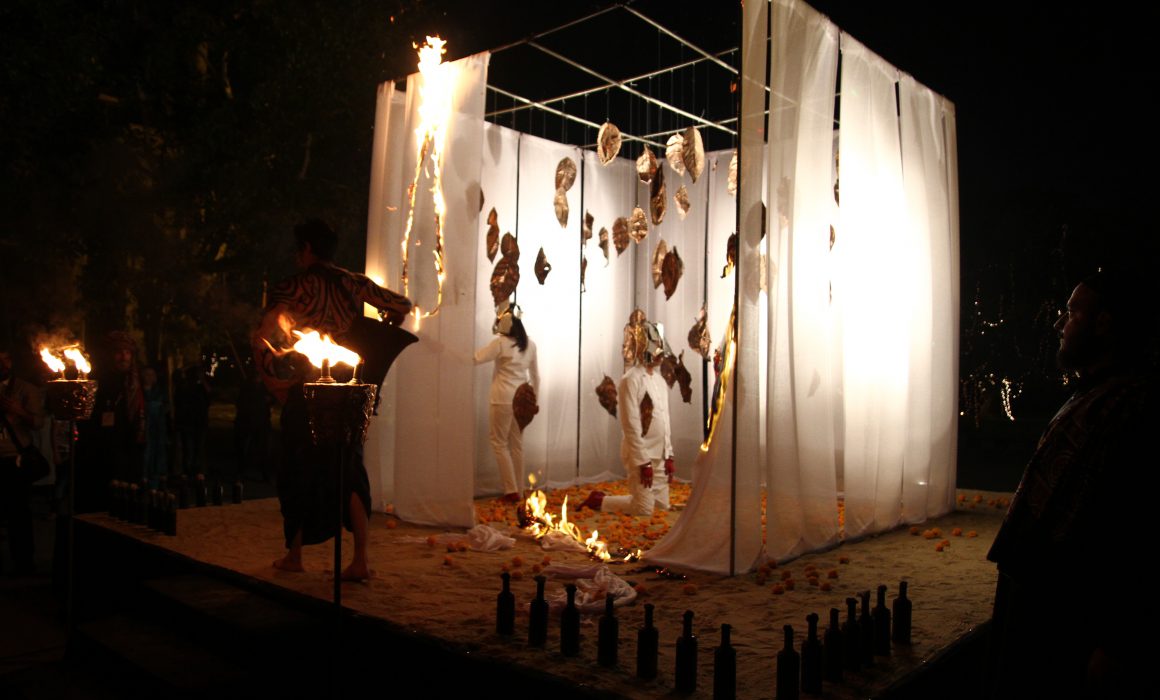On buffalos and books
Art Fest 2014 challenges the boundaries between high art and popular taste
A few days after the opening of ‘Art Fest 2014’ as part of the Sindh Festival, the role of gallery as a public or private space was discussed in the session Challenges Faced by the Art Galleries at the Karachi Literature Festival. Participants on the panel talked about art being an exclusive activity, the high prices, common people finding it hard to reach the major galleries situated in posh areas and the lack of public venues and art museums.
One can categorise this as a cynical response (a useful term to deny something we disagree with!) but the select art circle is a reality. The discourse on art is also predominantly conducted in a language that is not widely spoken or understood. Yet, there is a yearning for the inclusion of general public into art and lamenting its absence. More so because artists are addressing issues which are connected to a silent (or blind?) majority. But their chosen language of expression sometimes eludes an ordinary viewer.
A recent event, the ‘Art Fest’ at the Frere Hall Karachi (Feb 2-15, 2014) turned into an attempt to bring art and people closer to each other. The ‘Art Fest’ was curated by the Canvas Gallery and Vasl Artists’ Collective, and included art pieces from Shaheed Benazir Bhutto’s personal collection as well as modern and contemporary works by 63 artists, all belonging to the province of Sindh. Common people kept visiting the venue, so the event became a means to challenge, bridge and even break the boundaries between high art and popular taste.
Even though it was only artists from Sindh who were selected or invited for the ‘Art Fest’, one realised it was merely a mechanical or technical detail; in majority of these works, one failed to find a connection between the domicile of the artists and their artistic concerns or imagery. This was primarily because most artists had been moving from one location/province to the other. Like other spheres of society, the small art world of Pakistan can not be contained into one ethnical, racial or spatial identity. Here, the differences in artists’ places of origin or their adopted cities are diffused.
So more than the divide between Sindh and other provinces, in terms of art it was the distinction between modern and contemporary that became more obvious. One noticed modern works by artists such as Sadequain, Jamil Naqsh, Gulgee, Ahmed Pervaiz and several others, which presented a specific idea of art and its association with certain mediums (oil etc.), scale (suited for homes) as well as content (stylized, figurative or abstract surfaces).
On the other hand, the works of contemporary art displayed mostly in the curated section of the exhibition reflected how the new forms of expressions are turning into viable voices. Images, techniques and mediums — considered remote from the ordinary audience — were displayed in public and invited a response. This response could not have been measured or grasped but the mere fact these pieces were occupying public domain was a step in bringing the works of major artists to a layperson.
Perhaps the most exciting exhibit in this show was ‘I Saw it Once at the Indus Valley Civilization’, a fiberglass and found books installation that comprised a large buffalo sitting on a block of books. The work invited a viewer’s interest not only in the way the domestic and familiar creature was constructed (lifelike) but in how both parts of the work were composed and completed the narrative. The relationship of a local animal with books, mostly imported from the West and in English language, was intriguing; it indicated the connection and tension between the two modes of existence and different world views.
Due to its quixotic theme and unusual treatment, the work attracted a number of people and their admiration both from informed individuals and the ordinary crowd. A significant statement into popularity and quality — that if a work manages to break conventional limits and existing classifications, it appeals to masses and specialists, equally. This phenomenon is seen in the innumerable reprints of books by Nobel Prize winning authors.
The extension of art from a few to a vast number was witnessed in the work of Ayaz Jokhio too, though with a separate strategy. His self portraits (99 in numbers) were given to various people for adding colour in these identical images. Each person chose to use a different palette; so all the frames showed the same face in multiple hues. A usual exercise in colour perhaps could be read as locating similarity among differences, or accepting diversity in an apparent and accepted unity. However, the political content of the installation was not pronounced due to its alluring formal aspects.
In this regard, one could compare it to the canvas of Muhammad Ali Talpur in which the artist, after inscribing lines of a national song, filled the letters with more ink so the actual/initial words seemed as spots, instead of a readable text. The work, in our present conditions, served as a comment on the fervour of nationalism and patriotic pride.
Many artists, including Naiza Khan, Adeela Suleman, Mehr Afroz, Seema Nusrat, Adeel uz Zafar, Muhammad Zeeshan, Imran Channa, Irfan Hassan, Amin Gulgee, Mussarat Mirza and others displayed their works which expanded the notion of art. But more than that, the idea of taking art out of private galleries and homes of collectors into a shared space and inviting the public to look, like and love it is a matter of celebration for all.
By Quddus Mirza – February 16, 2014
Source: tns.thenews.com.pk



